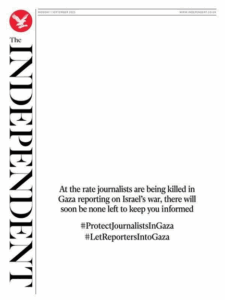Over 250 global media outlets stage ‘blackout’ to protest Israeli killing of Gaza journalists

The front page of The Independent, left blank in protest of the IDF’s killing of Palestinian journalists in Gaza, 1 September 2025
Rachel Fink and Ido David Cohen report in Haaretz on 1 September 2025:
Over 250 global media outlets from over 70 countries staged an unprecedented coordinated “blackout” to protest the killing of journalists in Gaza by Israeli forces.
The initiative, organized by Reporters Without Borders alongside campaign platform Avaaz and the International Federation of Journalists, saw newspapers around the globe publish black front pages, broadcasters interrupt programming, and digital outlets darken their homepages in a show of solidarity with Gazan journalists who have been killed since Israel’s military campaign began over a year and a half ago. –
“At the rate journalists are being killed in Gaza by the Israeli army, there will soon be no one left to keep you informed,” Thibaut Bruttin, general director of RSF, said in a press release posted to the organization’s website. This isn’t just a war against Gaza, it’s a war against journalism.”
Major outlets joining the blackout included The Independent in the United Kingdom, Mediapart in France, Der Freitag in Germany, Spain’s RTVE, Lebanon’s L’Orient Le Jour, The New Arab, Taiwan’s New Bloom, Brazil’s Agência Pública, and Qatar’s Al Jazeera.
Israel’s Foreign Ministry, in response, said the outlets chose “to throw values of the press and plurality of opinions into the trash, and instead publish a uniform, pre-scripted political manifesto against Israel – that tells you how great the bias against Israel is in the global media.”
Despite Israel not allowing foreign journalists inside Gaza, the Foreign Ministry added that “The reports we see in the global media regarding Gaza do not tell the real story there. They tell the campaign of lies that Hamas spreads. This is not journalism. This is politics.”
In the Netherlands, NRC ran a black front page with the words “Without reporters, the image from Gaza goes black,” while De Volkskrant filled its cover with portraits of slain journalists and several pages inside with their stories. Free Press Unlimited, a Dutch NGO, also used the occasion to call on its government to pressure Israel, accusing the IDF of running a “systematic smear campaign” to portray Palestinian journalists as Hamas militants.
The Guardian’s online edition prominently displayed the names and faces of every Palestinian journalist listed by the Committee to Protect Journalists as killed by Israeli military action. “The names on this list not only constitute lost lives, futures and grieving families, but the loss of a generation of journalists killed doing their jobs in the most frightening and devastating of environments, whose bravery and dedication to covering this conflict cannot be replaced,” the paper wrote.
“Palestinian reporters are being threatened, directly targeted and murdered by Israeli forces,” CPJ told The Guardian. “By silencing the press – those who document and bear witness – Israel is silencing the war.”
Individual reporters also amplified the campaign across social media. British investigative journalist Carole Cadwalladr called the tribute “a powerful act of witness,” adding that it was “a reminder that journalism is under attack and that the world must not look away from Gaza.”
According to RSF and the CPJ, at least 210 to 220 journalists have been killed in Gaza since October 2023, making it the deadliest conflict for reporters ever documented. Dozens more have been injured, detained or disappeared.
The killings include several recent high-profile strikes, including last week’s “double tap” strike on Nasser Hospital that killed five journalists and one on August 10 that killed Al Jazeera correspondent Anas al-Sharif.
The IDF claimed al-Sharif was a Hamas commander involved in planning rocket attacks against civilians and IDF troops, something both he and Al Jazeera denied before his killing. International human rights organizations, press freedom groups and journalists’ unions condemned it, calling his killing a devastating blow to independent reporting in Gaza and a serious violation of international law. Both RSF and the Committee to Protect Journalists have called for an independent investigation.
The message also resonated among journalists in Israel itself. On Sunday, over 130 Israeli journalists signed a petition calling to stop the killing of their colleagues in Gaza, end the war, and secure a hostage deal.
Among them were 50 Haaretz reporters and others from Calcalist, Time Out, and The Hottest Place in Hell. The petition condemned Israel’s record as “the country responsible for the highest number of journalist killings in 2024,” and criticized domestic media for failing to cover the human toll of the war.
Outlets such as Local Call and +972 Magazine participated in the RSF blackout campaign, joining what organizers described as the largest global editorial protest in recent history.
This article is reproduced in its entirety
